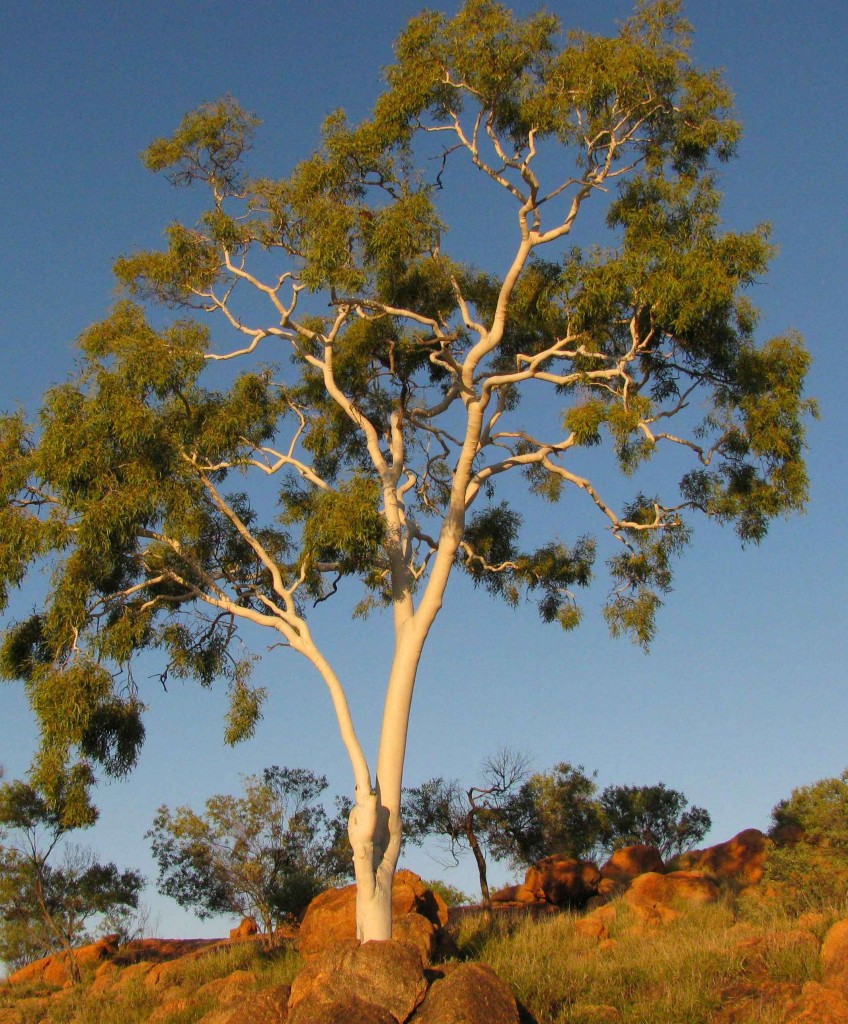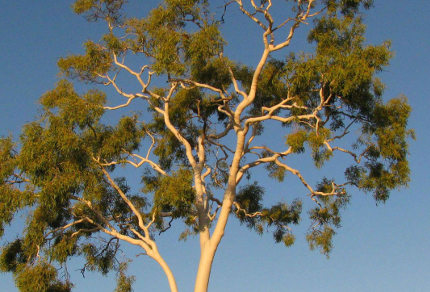
Ghost Gum, Alice Springs, Northern Territory (© Magi Nams)
Kookaburra sits in the old gum tree, I sang as a child in school, and sang to my sons when they were young. At some point, I learned that ‘the old gum tree’ was a eucalypt, but then I had no idea that more than 700 species of eucalypts exist in Australia1 or that the term ‘gum’ refers in a general way to them all.2 However, today I finished reading a book called Gum: The story of eucalypts and their champions, written by journalist Ashley Hay. It contained a multitude of intriguing facts and anecdotes about gum trees, some of which I relate below.
It was Joseph Banks, a brilliant and wealthy young botanist who sailed to the South Pacific with James Cook on the Endeavour3, who first suggested a name for these unusual trees with their open canopies and vertically-hanging leaves, and trunks that oozed a sticky resin. He called them Sanguis draconis, meaning ‘dragon’s blood’4 and upon encountering such resin-oozing trees at many sites on the east coast of Australia in 1770, began calling them gum trees.5 Enthralled with the unusual vegetation surrounding what became known as Botany Bay,4 Banks collected thousands of specimens to send back to London, many of which were leaves and flowers and fruits of gum trees.5
Although Banks fully intended to study the specimens he had collected and assign them scientific names, that never happened. His life became too busy.6 Instead, it was a Frenchman, Charles Louis L’Héritier de Brutelle, who had never been to Australia but was a keen tree botanist enraptured by Banks’ vast collection, who invented the name Eucalyptus.7 In 1786, he studied the flowers and leaves of a particular specimen and was struck by the protective covering around the growing flower. He combined two Greek words, eu and klyptus, meaning ‘well’ ‘covered.’8 Thus arose the genus Eucalyptus.
I looked through a book of Australian forest trees I had borrowed from the library and noticed that many eucalypts carry only scientific names. Others, however, are known by common names as well. Blue gum. Box. Peppermint gum. Blackbutt. Snow gum. Ghost gum. Mountain ash. Scribbly gum. River red gum. Woollybutt. Salmon gum. Bloodwood. Ironbark. Scarlet gum. Stringybark. Poplar gum. Some are commonly called by the names Australia’s first people gave them long before white people ever saw this continent. Jarrah. Coolibah. Yarra.9
When the First Fleet arrived and settlement began, the new colonists learned that eucalypts blunt axes extremely quickly and that the trunks of numerous varieties twist and curve, resulting in poor grain for lumber. Many considered them useless.10 However, Major Thomas Livingston Mitchell, who arrived from England in 1827 to survey the new colony11 and stayed on to complete four expeditions into what was wilderness to him,12 found the gums increasing beautiful.13 He learned from his Aboriginal guides that river red gums, which his guides called yarra, marked watercourses,14 and that a green gum branch held out in front was considered a peace offering.15 He wrote stories of his adventures and sent them to Europe, where they became extremely popular and introduced a faraway continent to a land of gum trees.16
In her book, Hay describes other champions of gum trees – Ferdinand Müller, a German pharmacist and botanist17 who in the second half of the 19th century brought the study of Australian trees home to Australia18; May Gibbs, an artist and writer who created chubby, winged sprites peering out from behind gum leaves, which she called the Gum-Nut Babies and which captured the imagination of the nation in the early 20th century;19 Max Jacobs, a forester20 who, after World War II, promoted eucalypts to the world as easy-germinating, fast-growing plantation species21; and Geoff Law, an environmental activist who was instrumental in stopping the logging of old-growth eucalypt forests on Tasmania,22 where the tallest trees in Australia grow.23 Those big gums are the tallest hardwoods, the tallest flowering plants in the world.24 Law, like Mitchell, was struck by the beauty of the forest giants, and like Gibbs, caught the imagination of Australians with his campaigns to make the populace aware of what was happening to the country’s forest heritage, namely that the huge trees were being destroyed to make wood chips for export.25
That took the book up to the end of the 20th century and start of a new millennium, the here and now. Reading it made me appreciate the incredible energy and ardour for trees displayed by Australia’s early botanists. It made me want to read the Gum-Nut Babies books, and to see those big trees in the Styx Valley of Tasmania. (As soon as I post this blog, I’m going to look up the Styx on the Tassie map. We’re going there.) It made me understand, a little, of what gum trees came to mean to Australians.26 During World War I, Aussies fighting overseas referred to themselves as ‘gumsuckers’ to make it clear they were Australian-born and not English.26 Soldiers received aromatic gum leaves in letters sent by women who loved them and wanted them to have a reminder of their beloved homeland.27 Poets like Nathan Spielvogel28 and artists like John Glover29 and Louis Buvelot30 sought to capture the essence of gums, which was, in many ways, the essence of Australia itself.
References:
1. Ashley Hay. Gum: The story of eucalytps and their champions. 2002. Duffy&Snellgrove, Sydney. p. 2; 2. Ibid, p.4; 3. Ibid, p. 10; 4. Ibid, p.14; 5. Ibid, p.16; 6. Ibid, pp. 19-20; 7. Ibid, p. 23: 8. Ibid, pp. 23-24.
9. M.W. McDonald, coordinator. Forest Trees of Australia. 2006. CSIRO Publishing, Collingwood, Victoria. pp. 218-606.
10. Hay, p. 27; 11. Ibid, pp. 41; 12. Ibid, p. 67; 13. Ibid, p. 63-64; 14. Ibid, p. 63; 15. Ibid, p. 62; 16. Ibid, p. 66; 17. Ibid, pp. 71-72; 18. Ibid, p. 101-103; 19. Ibid, pp. 113-115; 20. Ibid, pp. 144-145; 21. Ibid, pp. 147-149; 22. Ibid, p. 179; 23. Ibid, p. 185; 24. Ibid, p. 191; 25. Ibid, p. 183, 185; 26. Ibid, p. 115; 27. Ibid, p. 117; 28. Ibid, pp. 115-116; 29. Ibid, pp. 57-59; 30. Ibid, p. 107.


